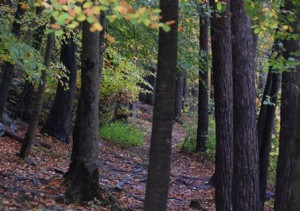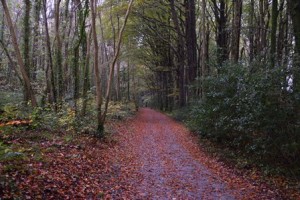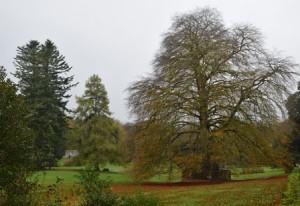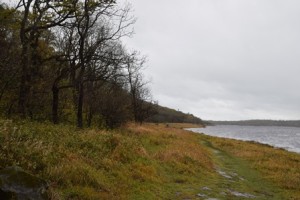19 Wild Swans at Coole
Posted by Christine on Oct 29, 2014 in Ireland | 2 comments
“Easter, 1916” is probably William Butler Yeats’s most important poem, “The Lake Isle of Innisfree” his most well known, but for those who read a lot of Yeats, “The Wild Swans at Coole” may be his most beloved. It is certainly the most popular poem among the students I bring to Ireland every two years: they compete fiercely to read the poem aloud when we visit Coole Park, and sometimes we have to have more than one performance.
Over the weekend Ron and I were down in Limerick and North Kerry enjoying several beautiful fall days in the countryside. Though it looked like rain on Sunday, Ron came up with the brilliant idea to drive a little bit out of our way on the way home to stop off at Coole Park, once the home of Yeats’s friend, patron, and collaborator Lady Augusta Gregory, now a property of the National Parks and Wildlife Service. What better way to end our weekend trip than a late October walk in the woods in the rain?
When we arrived at Coole, the trees were certainly “in their autumn beauty,” though “the woodland paths” were far from dry. Lady Gregory’s house—where she entertained Yeats, John Millington Synge, George Bernard Shaw, Sean O’Casey, George Moore, Violet Martin, and many more of the well-known Irish writers of her day—is long gone; only the foundation and the clearing reveal its location “In the Seven Woods” Yeats wrote about, 1000 acres of forest, and today, six kilometers of trails. The presence of so many writers at Coole is confirmed at the Autograph Tree, a glorious copper beech in the walled garden. The tradition began in 1898 when Lady Gregory asked Yeats to carve his name on the tree.
I’ve been to Coole many times, most often in the winter with student groups. I’ve seen it flooded, iced over, and on several spring and summer visits, fully abloom in a thousand shades of green. But I’d never been there in the season when the poem was written. We visited in early afternoon, not twilight, and it rained quite a bit during our visit, but the lake was “brimming,” and “among the stones” we did see, if not “nine and fifty,” about thirty or so wild swans, drifting “on the still water, / Mysterious, beautiful.”
 Yeats wrote “The Wild Swans at Coole” at Coole Park a few months after writing “Easter, 1916.” He had returned to Ireland from living abroad not long after the turmoil of the Easter Rising and would, within the next eighteen months or so, purchase a dilapidated Norman tower quite near Coole Park and marry Bertha Georgiana Hyde Lees (“George”), having given up on his longstanding quest to persuade the actress and activist Maud Gonne to marry him. I won’t interpret the poem for you—you can do that—except to say it is certainly about a turning point, many people seeing it as a change in personal and artistic direction for Yeats, others seeing wider implications for Ireland and its changing fortunes. Some even see it as a companion piece to “Easter, 1916.”
Yeats wrote “The Wild Swans at Coole” at Coole Park a few months after writing “Easter, 1916.” He had returned to Ireland from living abroad not long after the turmoil of the Easter Rising and would, within the next eighteen months or so, purchase a dilapidated Norman tower quite near Coole Park and marry Bertha Georgiana Hyde Lees (“George”), having given up on his longstanding quest to persuade the actress and activist Maud Gonne to marry him. I won’t interpret the poem for you—you can do that—except to say it is certainly about a turning point, many people seeing it as a change in personal and artistic direction for Yeats, others seeing wider implications for Ireland and its changing fortunes. Some even see it as a companion piece to “Easter, 1916.”
I fell in the love with this poem before I knew anything about Ireland, or Yeats, or poetry, for that matter. I loved the way it sounded. I loved the idea of returning to a place year after year and marking the occasion in some way. I memorized lines without intending to, always a good sign. With its autumnal tones, enigmatic swans, and final question, the poem was and is both “mysterious” and “beautiful” to me.
You don’t always see wild swans at Coole, so we were fortunate in our rainy day walk in the woods and along the shore of Coole Lake.
The Wild Swans at Coole
by W. B. Yeats
The trees are in their autumn beauty,
The woodland paths are dry,
Under the October twilight the water
Mirrors a still sky;
Upon the brimming water among the stones
Are nine-and-fifty swans.The nineteenth autumn has come upon me
Since I first made my count;
I saw, before I had well finished,
All suddenly mount
And scatter wheeling in great broken rings
Upon their clamorous wings.I have looked upon those brilliant creatures,
And now my heart is sore.
All’s changed since I, hearing at twilight,
The first time on this shore,
The bell-beat of their wings above my head,
Trod with a lighter tread.Unwearied still, lover by lover,
They paddle in the cold
Companionable streams or climb the air;
Their hearts have not grown old;
Passion or conquest, wander where they will,
Attend upon them still.But now they drift on the still water,
Mysterious, beautiful;
Among what rushes will they build,
By what lake’s edge or pool
Delight men’s eyes when I awake some day
To find they have flown away?The Collected Poems of W. B. Yeats (1989)



Beautiful!
Beautiful. How I wish I could walk those woodland paths right now! Thank you for the virtual visit!